Prints charming: colour and pattern through the eyes of Josef Frank

London’s Fashion and Textile Museum is adorned with bright and beautiful fabrics that look as relevant today as they did when they were designed more than six decades ago.
Around 30 of Josef Frank’s textile patterns hang in the ground-floor gallery, allowing visitors to appreciate the Austrian’s extraordinary creativity and technical prowess. The dream-like scenes of bold, multicoloured flora and fauna are expertly executed in complicated repeat patterns.
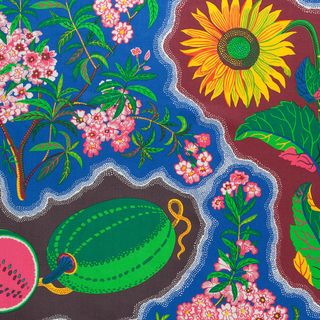
Dixieland, by Josef Frank, for Svenskt Tenn
Frank – who was born in Austria in 1885 and worked in Sweden, then in New York – wore as many hats as he had addresses. He started out as an architect, and that is still what he is best known for in Austria. But with his move to Stockholm in 1933, his colourful take on modernism took off in the form of prints, glassware, metalwork and interior design. His energy found an outlet through his collaboration with the Swedish retailer Svenskt Tenn, where as chief designer he created 160 prints as well as furniture and tableware.
Dennis Nothdruft, curator at the Fashion and Textile Museum, admits that initially, ‘there may have been some skepticism’, in straightlaced 1930s Sweden, concerning the outlandish vibrancy of Frank’s imagery, ‘but it helped shape Swedish design’.
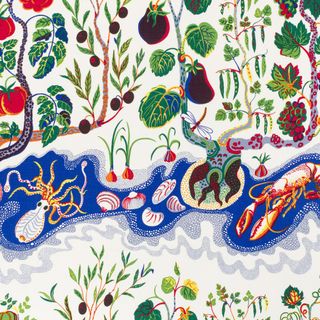
Italian Dinner, by Josef Frank, for Svenskt Tenn
A key part of ‘Josef Frank: Patterns-Furniture-Painting’ are his ‘classics’ including those influenced by his time in the US, Dixieland and Manhattan. ‘Tulips’ is ubiquitous in Sweden, while Nothdruft’s favourite is ‘Italian Dinner’ (above) – a large-scale depiction of sumptuous foodstuffs.
For his interiors projects, like the famous house in the grounds of Stockholm’s Millesgården that he designed with Estrid Ericson, Frank believed in white walls and coloured fabrics. A room set on the museum’s ground floor displays his belief that you should mix eight different patterns to create a calm, peaceful environment.
The designs of Frank, who died in 1967, are being kept alive and available by Svenskt Tenn. Meanwhile his influence continues to be felt in two other Nordic design powerhouses, Marimekko and IKEA.
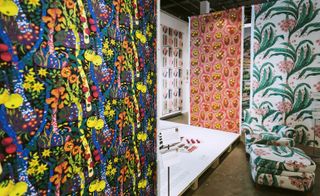
A key part of ‘Josef Frank: Patterns-Furniture-Painting’ are his ‘classics’, including those influenced by his time in the US, Dixieland and Manhattan

Himalaya', by Josef Frank, for Svensk Tenn
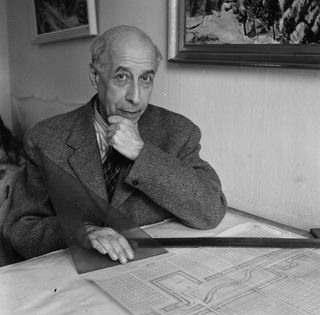
Frank was born in Austria in and worked in Sweden, then in New York
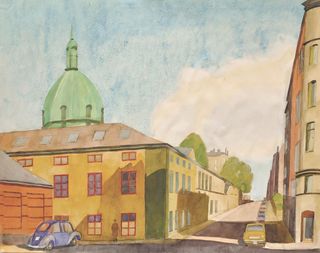
Also on show, a selection of previously unseen watercolours by Frank. Pictured, Artillerigatan Stockholm Watercolour, 1953-67.
INFORMATION
’Josef Frank: Patterns-Furniture-Painting’ is on view until 7 May. For more information, visit the website
ADDRESS
Fashion and Textile Museum
83 Bermondsey Street, London
SE1 3XF
Wallpaper* Newsletter
Receive our daily digest of inspiration, escapism and design stories from around the world direct to your inbox
-
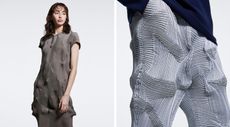 Get to know Issey Miyake’s innovative A-POC ABLE line as it arrives in the UK
Get to know Issey Miyake’s innovative A-POC ABLE line as it arrives in the UKAs A-POC ABLE Issey Miyake launches in London this week, designer Yoshiyuki Miyamae gives Wallpaper* the lowdown on the experimental Issey Miyake offshoot
By Jack Moss Published
-
 Eurovision unveils its 2024 stage, designed by Beyoncé's Renaissance Tour creatives
Eurovision unveils its 2024 stage, designed by Beyoncé's Renaissance Tour creativesThis year's stage design aims to bring the audience into the performance more than ever before.
By Charlotte Gunn Published
-
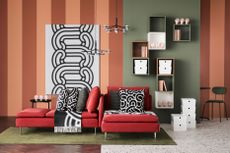 Ikea meets Japan in this new pattern-filled collection
Ikea meets Japan in this new pattern-filled collectionNew Ikea Sötrönn collection by Japanese artist Hiroko Takahashi brings Japan and Scandinavia together in a pattern-filled, joyful range for the home
By Rosa Bertoli Published
-
 ‘R for Repair’ at London Design Festival displays broken objects, re-formed
‘R for Repair’ at London Design Festival displays broken objects, re-formedIn the second half of a two-part exhibition and as part of London Design Festival 2022, ‘R for Repair’ at the V&A displays broken objects, re-formed
By Martha Elliott Last updated
-
 ‘Finding quality through the act of making’: Pearson Lloyd celebrates 25 years of design
‘Finding quality through the act of making’: Pearson Lloyd celebrates 25 years of designPearson Lloyd’s show ‘Change Making’ reflects on past designs from its archives, showcasing the influences on and evolution of the studio, from furniture design to the NHS
By Martha Elliott Last updated
-
 Tom Dixon marks his studio's 20 years with a show of design experiments
Tom Dixon marks his studio's 20 years with a show of design experimentsMushroom, cork, steel coral and more: Tom Dixon showcases an overview of his design experiments as he celebrates his practice's 20 years
By Rosa Bertoli Last updated
-
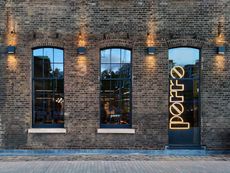 Porro unveils new London showroom at Coal Office
Porro unveils new London showroom at Coal OfficeLondon Design Festival 2022: industrial architecture meets pure geometries in the new Porro showroom, taking over a space within Tom Dixon’s Coal Office to showcase the brand’s systems and furniture
By Rosa Bertoli Last updated
-
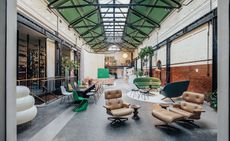 Vitra unveils new London home in the Tramshed, Shoreditch
Vitra unveils new London home in the Tramshed, ShoreditchLondon Design Festival 2022: after a year-long renovation, Vitra opens the door to its new showroom in the heart of Shoreditch
By Rosa Bertoli Last updated
-
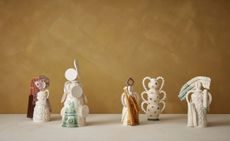 Mudlarking beside the River Thames inspires The New Craftsmen’s makers
Mudlarking beside the River Thames inspires The New Craftsmen’s makersLondon Design Festival 2022: The New Craftsmen’s new collection, ‘Claylarks’, features work from a group of creatives inspired by a River Thames mudlarking expedition
By Mary Cleary Last updated
-
 One tree, ten designers: SCP presents The One Tree Project at London Design Festival
One tree, ten designers: SCP presents The One Tree Project at London Design FestivalLondon Design Festival 2022: SCP enlisted ten British designers to create furniture and objects from a felled ash tree from founder Sheridan Coakley's Hampshire garden
By Francesca Perry Last updated
-
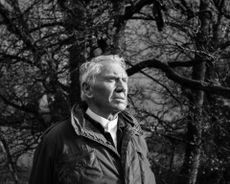 London Design Medals 2022
London Design Medals 2022London Design Medals 2022 are awarded to costume designer Sandy Powell, architect Indy Johar, researcher Joycelyn Longdon and photographer Sir Don McCullin
By Rosa Bertoli Last updated